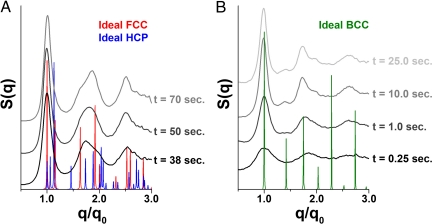Fig. 5.
Structural transition for 1- and 2-component systems. (A) SAXS profiles for the 1-component (short FCC) system show that early stages of crystal growth (t = 38 s; data at t < 38 s present the same pattern with broader peaks) exhibit a scattering pattern more closely resembling an HCP arrangement, whereas later stage crystals correspond to an FCC arrangement (t = 70 s). A mixture of the crystal systems is observed at intermediate time points (t = 50 s). Modeled scattering profiles for FCC and HCP crystals are shown in red and blue, respectively. (B) One-dimensional scans for the 2-component DNA-AuNP system, with an initial formation of disordered aggregates that quickly rearranges to a BCC crystal lattice. After this initial restructuring, the peaks grow in intensity and sharpen, indicating the growth of well-ordered crystals. The modeled scattering pattern for a perfect BCC crystal is shown in green.

